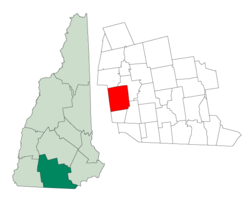Peterborough, New Hampshire
| Peterborough, New Hampshire | ||
|---|---|---|
| Town | ||

Town House, built in 1918
|
||
|
||
 Location in Hillsborough County, New Hampshire |
||
| Coordinates: 42°52′14″N 71°57′06″W / 42.87056°N 71.95167°WCoordinates: 42°52′14″N 71°57′06″W / 42.87056°N 71.95167°W | ||
| Country | United States | |
| State | New Hampshire | |
| County | Hillsborough | |
| Incorporated | 1760 | |
| Government | ||
| • Board of Selectmen | Ed Juengst, Chair Barbara Miller Tyler Ward |
|
| • Town Administrator | Rodney Bartlett | |
| Area | ||
| • Total | 38.1 sq mi (98.7 km2) | |
| • Land | 37.7 sq mi (97.7 km2) | |
| • Water | 0.4 sq mi (1.1 km2) 1.06% | |
| Elevation | 718 ft (219 m) | |
| Population (2010) | ||
| • Total | 6,284 | |
| • Density | 167/sq mi (64.3/km2) | |
| Time zone | Eastern (UTC-5) | |
| • Summer (DST) | Eastern (UTC-4) | |
| ZIP code | 03458 | |
| Area code(s) | 603 | |
| FIPS code | 33-60580 | |
| GNIS feature ID | 0873697 | |
| Website | www |
|
Peterborough is a town in Hillsborough County, New Hampshire, United States. The population was 6,284 at the 2010 census. The central settlement in town, with 3,103 people at the 2010 census, is defined as the Peterborough census-designated place (CDP) and is located along the Contoocook River at the junction of U.S. Route 202 and New Hampshire Route 101. The community is 38 miles (61 km) southwest of Manchester and 72 miles (116 km) northwest of Boston.
Granted by Massachusetts in 1737, it was first permanently settled in 1749. The town suffered several attacks during the French and Indian War. Nevertheless, by 1759, there were fifty families settled. Incorporated on January 17, 1760 by Governor Benning Wentworth, it was named after Lieutenant Peter Prescott (1709–1784) of Concord, Massachusetts, a prominent land speculator.
The Contoocook River and Nubanusit Brook offered numerous sites for watermills, and Peterborough became a prosperous mill town. In 1810, the first cotton factory was established. By 1859, when the population was 2,222, there were four additional cotton factories, plus a woolen mill. Other industries included two paper mills, an iron foundry, a machine shop, a carriage factory, a basket manufacturer, a maker of trusses and supporters, a boot and shoe factory, seven sawmills, and three gristmills.
...
Wikipedia

